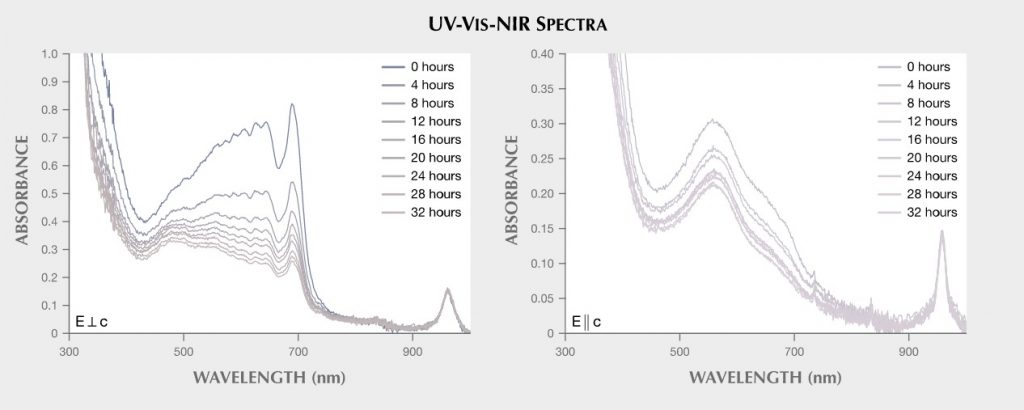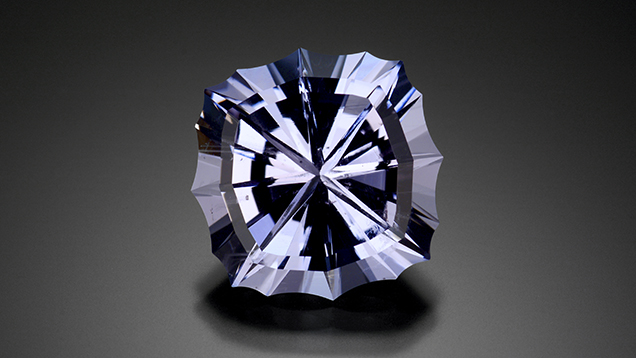Recently examined in the Carlsbad laboratory was a 26.72 ct transparent violet modified cushion mixed-cut stone (figure 1). Standard gemological testing revealed a refractive index of 1.583–1.592 and a specific gravity of 2.78, both consistent with beryl. Using plane-polarized light, pale purple and saturated blue pleochroic colors were observed. A uniaxial optic figure was seen at the girdle, and the optical orientation of the stone showed the stronger blue pleochroic color down the optic axis direction. The stone was inert to long-wave UV light and fluoresced weak greenish yellow to short-wave UV. Viewed with fiber-optic light during microscopic examination, it displayed a few scattered blocky crystals, platelets, and needles, confirming natural growth origin. No coatings were seen on the surface under reflective light. Other than the unusual violet color, these properties were consistent with Maxixe beryl.

Advanced testing by LA-ICP-MS revealed that the stone lacked iron. This result was consistent with Maxixe beryl, in which iron is too low to be measured (I. Adamo et al., “Aquamarine, Maxixe-type beryl, and hydrothermal synthetic blue beryl: Analysis and identification,” Fall 2008 G&G, pp. 214–226). Maxixe beryl normally has a blue to violet blue bodycolor, but this stone showed an unusual violet color. The UV-Vis-NIR spectrum (figure 2) showed absorption bands between 500 and 700 nm and a broad band near ~690 nm. This spectrum was consistent with Maxixe beryl (again, see Adamo et al., 2008). While Maxixe beryl has been found to be colored by natural irradiation, it can also be produced by artificial irradiation. Some of these “Maxixe-type” beryls produced by artificial irradiation are known to fade when exposed to “mild heat or strong light” (see Winter 1997 Lab Notes, p. 293). However, there is no conclusive test to determine whether Maxixe color results from natural or artificial irradiation, and as such, beryl in the blue to violet color range that shows the type of visible spectrum previously mentioned is designated simply as the Maxixe variety of beryl by the GIA laboratory.


A small sample cut from the same rough as the 26.72 ct violet beryl was provided by lapidary Nolan Sponsler for destructive testing in order to evaluate the color stability of this material. An optically oriented wafer, 4.45 mm thick and normalized to a 25 mm path length in order to better observe the change in color, was fabricated from this sample with parallel polished windows that are parallel to the optic axis to allow measurement of the o- and e-rays. UV-Vis-NIR spectra were collected on the sample prior to fade testing and at four-hour intervals of exposure to a 150-watt halogen bulb at a distance of approximately four inches from the bulb to avoid any significant heating (figure 3). The results showed fading of the sample until its color was very pale (figure 4), confirming that this material may fade. One should avoid prolonged exposure to light and store it in a dark environment to preserve the color.
This violet Maxixe beryl was purported to be from Santa Maria de Itabira, Minas Gerais, Brazil. It is notable for its unusual color and its fantasy cut design. In addition to this violet Maxixe beryl, another violet beryl group mineral named “johnkoivulaite” was documented in 2019 (see Fall 2019 GNI, pp. 454–455); that new beryl is from the Mogok mining area in Myanmar. However, standard gemological properties clearly separate the two violet beryl minerals. Even though this beryl owes its appealing violet hue to what would be considered an unstable color center, the color should remain intact if prolonged exposure to intense light sources is minimized.
Article republished with permission from GIA
https://www.gia.edu/gems-gemology/fall-2020-gemnews-unusual-violet-maxixe-beryl

